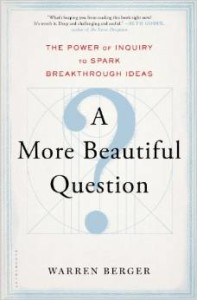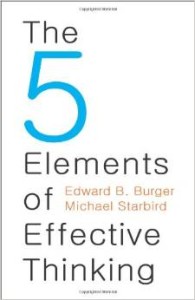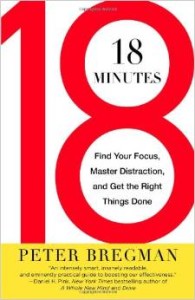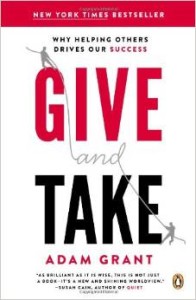Books for the nonprofit sector are wonderful tools for helping you to navigate the world of fundraising and communications, board training, and grant proposal writing. But sometimes the world of nonprofit fundraising can be a bit…shall we say, insular. In addition to reading all the latest fundraising-specific books, I make it a point to read business and human potential books (usually 5-10 a month). Most fall by the wayside after only a chapter or two, while others manage to deliver lessons that seem tailored to nonprofit fundraising.
What lessons can you learn from my favorite recent non-fundraising fundraising books?
A More Beautiful Question: The Power of Inquiry to Spark Breakthrough Ideas*. Warren Berger.
It’s been my experience that nonprofits are often asking the wrong questions:
“Why won’t our board members ask their friends for money?”
“Why don’t our gala attendees ever donate?”
“How can we get our alumni to give back annually?”
“How can we raise enough money to continue with the work that we’re doing?”
“How do we create a first time donor plan — one that keeps them giving?”
Worthy questions, right? After all, they came directly from my readers. But are they “beautiful” questions?
 In his book, A More Beautiful Question: The Power of Inquiry to Spark Breakthrough Ideas, Warren Berger shows that one of the most powerful forces for igniting change is, no, not necessarily more information — we’re bombarded with more information now than ever before — but the power of questioning.
In his book, A More Beautiful Question: The Power of Inquiry to Spark Breakthrough Ideas, Warren Berger shows that one of the most powerful forces for igniting change is, no, not necessarily more information — we’re bombarded with more information now than ever before — but the power of questioning.
And he tells the inspiring story of Van Phillips. He’s the guy that invented the mind-blowing “blade runner” prosthetic device. When Phillips lost his leg in a boating accident, he could have asked the usual question. Why me? Instead he went further, asking “If they can put a man on the moon, why can’t they make a decent foot?” Then he took ownership of the question: How can I make a better foot?
And the rest is pretty much history.
It’s easy, when you’re confronted with a challenge that seems insurmountable, with the question Oh my God, what are we going to do? What if, instead you asked “What if this change represents an opportunity for us?”
Let’s turn it around now. What are your “beautiful” questions?
How can we know our donors on a deeper level?
What do our alumni need to hear from us in order to feel genuinely appreciated?
How can we surprise and delight our donors?
What is the donor experience when they make a first time gift? How can we make it better?
How can we empower our board members to be amazing fundraisers?
Sometimes all your challenge needs is some reframing.
Essentialism: The Disciplined Pursuit of Less. Greg McKeown .
 When someone recommended this book, I initially thought it was about over consumption . Then, after I read it, I realized that it was about what I’ve been preaching for years — focusing on what really matters.
When someone recommended this book, I initially thought it was about over consumption . Then, after I read it, I realized that it was about what I’ve been preaching for years — focusing on what really matters.
When you’re:
- Tying goodie bags for tomorrow night’s ‘gala,’
- Running around picking up donated silent auction items
- Scrambling to meet a grant deadline when you don’t have a snowball’s chance in hell of getting the grant (or, if you do get it, the paperwork will hardly be worth it)
you’re definitely busy — there are never enough hours in the day. But are you focused on what really matters — your donors?
The Five Elements of Effective Thinking. Edward B. Burger, Michael Starbird
The 5 Elements of Effective Thinking presents practical, lively, and inspiring ways for you to become more successful through better thinking. The idea is  simple: You can learn how to think far better by adopting specific strategies. Brilliant people aren’t a special breed–they just use their minds differently.
simple: You can learn how to think far better by adopting specific strategies. Brilliant people aren’t a special breed–they just use their minds differently.
My favorite of the five elements has to do with mastery. So what do you need to master to grow your individual donor program?
- Telling your story and telling it well
- Thanking your donors well – and promptly
- Understanding what motivates your donors
- Digging deep into direct response in all its formats
- Understanding and truly ‘getting’ donor-centricity
When you understand these basics, you move clean away from the *begging for dollars* mindset so prevalent in our field, and embrace your donors as what they are: partners in creating change. Understand these fundamentals and you understand that everyone is responsible for fundraising. Understand these basics and everything else flows.
Tony Robbins said it well: “Most people have no idea of the giant capacity we can immediately command when we focus all of our resources on mastering a single area of our lives.”
18 Minutes: Find Your Focus, Master Distraction, and Get the Right Things Done. Peter Bregman
You know how it goes. You start your day with the best of intentions, walking into the office bright-eyed and determined, knowing exactly what you want to accomplish.
Then you sit down to the computer to check your email.
 Hours later you’re bogged down in one crisis after another, chasing after a grant opportunity a board member has emailed you, trying to locate a new event venue after the restaurant you booked bailed on you, trying to figure out how you’re going to explain to your boss why your year-end appeal raised less than last year.
Hours later you’re bogged down in one crisis after another, chasing after a grant opportunity a board member has emailed you, trying to locate a new event venue after the restaurant you booked bailed on you, trying to figure out how you’re going to explain to your boss why your year-end appeal raised less than last year.
Before you know it your day has flown out the window.
How do you stick to your plan when there are so many distractions and fires to put out along the way?
Create a ritual.
In his book, 18 Minutes: Find Your Focus, Master Distraction, and Get the Right Things Done, Peter Bregman tells the story of the secret of Jack LaLanne’s success. LaLanne, a fitness visionary and showman, was also the founder of The Jack LaLanne Show, the longest-running television fitness program, airing for thirty-four years.
Bregman writes that LaLanne “…had one trick that I believe was his real secret power. Ritual. Right up until his death at the age of ninety-six, he spent the first two hours of every day exercising. Ninety minutes lifting weights and thirty minutes swimming or walking. Every morning. That ritual enabled him to achieve his goals of staying fit, healthy, and strong.”
You can develop rituals too.
Going into 2014, make donor retention your number one priority. Before turning on your computer, before checking your email, make it a point to call one to three donors to thank them for their last gift.
The power of ritual lies in its very predictability. “If you do the same thing in the same way over and over again, the outcome is predictable.” Try it. You’ll definitely get the right things done.
Give and Take: A Revolutionary Approach to Success. Dr. Adam Grant
Give and Take: A Revolutionary Approach to Success, explains why being a giver is the best ‘strategy’ for business success.
Could it be the best strategy for your nonprofit’s success as well? Adam Grant talks about the world of givers, matchers, and takers (and you’ll know exactly what he’s talking about as  you reflect upon the people you meet every day – take a seat and let me tell you about the *mean girl* syndrome so prevalent in our sector). Throughout the book Grant gives tangible examples of the difference between the world views of those who give and those who take. In a chapter entitled “The Peacock and the Panda,” he instructs readers on how to spot a taker in a giver’s clothes, pointing out that “takers are often good fakers.” Ken Lay of Enron is cited as a prime example, a man who, on the surface with his charitable foundation and talk of integrity, gave the appearance of being a giver, but was in reality a manipulative self-server.
you reflect upon the people you meet every day – take a seat and let me tell you about the *mean girl* syndrome so prevalent in our sector). Throughout the book Grant gives tangible examples of the difference between the world views of those who give and those who take. In a chapter entitled “The Peacock and the Panda,” he instructs readers on how to spot a taker in a giver’s clothes, pointing out that “takers are often good fakers.” Ken Lay of Enron is cited as a prime example, a man who, on the surface with his charitable foundation and talk of integrity, gave the appearance of being a giver, but was in reality a manipulative self-server.
Grant shares a marvelous story about the real power is in what he calls “powerless communication,” telling a tale of a young lawyer going up against a polished defense attorney with 25 years of experience — who wins over the jury with a stutter. Grant notes that, while the slick, assertive monologues seem to carry the day, it can be the slightly hesitant, yet “realer” speech that wins out. ”Takers tend to worry that revealing weaknesses will compromise their dominance and authority. Givers are much more comfortable expressing vulnerability: they’re interested in helping others, not gaining power over them, so they’re not afraid of exposing chinks in their armor. By making themselves vulnerable, givers can actually build prestige.” How could this work for you? You’re already a natural giver. Take it even further. Don’t be afraid to show vulnerability, to be genuine and transparent. Don’t shy away from connecting with your donors on a very real and personal level. Make those daily thank you phone calls, make the time for handwritten notes and cards, and even fun little gifts. Make your communications real. Practice writing regularly, and don’t worry if you’re not a writer…let your clients and your donors say it for you.
* Amazon affiliate links.
There you have it. My favorite non-fundraising fundraising books of the past few years. What are yours?

















 I can’t wait to meet with you personally.
I can’t wait to meet with you personally.
Comments on this entry are closed.